![[UTW]_Shinsekai_Yori_-_14_[h264-720p][C090297E].mkv_snapshot_05.34_[2013.01.05_21.55.27] [UTW]_Shinsekai_Yori_-_14_[h264-720p][C090297E].mkv_snapshot_05.34_[2013.01.05_21.55.27]](https://lh5.ggpht.com/-HWKzM8Dlt4Y/UOg4pSKvf1I/AAAAAAACYhI/8mfuC7hQSrU/%25255BUTW%25255D_Shinsekai_Yori_-_14_%25255Bh264-720p%25255D%25255BC090297E%25255D.mkv_snapshot_05.34_%25255B2013.01.05_21.55.27%25255D_thumb.jpg?imgmax=800) |
![[UTW]_Shinsekai_Yori_-_14_[h264-720p][C090297E].mkv_snapshot_13.28_[2013.01.05_22.03.32] [UTW]_Shinsekai_Yori_-_14_[h264-720p][C090297E].mkv_snapshot_13.28_[2013.01.05_22.03.32]](https://lh6.ggpht.com/-tY5E2YUjSVY/UOg4tK6FD2I/AAAAAAACYhY/XDS5lyH9FCQ/%25255BUTW%25255D_Shinsekai_Yori_-_14_%25255Bh264-720p%25255D%25255BC090297E%25255D.mkv_snapshot_13.28_%25255B2013.01.05_22.03.32%25255D_thumb.jpg?imgmax=800) |
![[UTW]_Shinsekai_Yori_-_14_[h264-720p][C090297E].mkv_snapshot_19.14_[2013.01.05_22.09.46] [UTW]_Shinsekai_Yori_-_14_[h264-720p][C090297E].mkv_snapshot_19.14_[2013.01.05_22.09.46]](https://lh4.ggpht.com/-Nwl2omcAtdc/UOg4w6RU16I/AAAAAAACYho/qj6TBYxaxIc/%25255BUTW%25255D_Shinsekai_Yori_-_14_%25255Bh264-720p%25255D%25255BC090297E%25255D.mkv_snapshot_19.14_%25255B2013.01.05_22.09.46%25255D_thumb.jpg?imgmax=800) |
This is the sort of series for which the phrase “The plot thickens” was invented.
I’ve lavished a lot of praise on this series over the first 13 episodes, which is fine because I think it’s deserved all of it. But I’m still finding myself struck by new things that impress me about the series every week. I think that’s because Shin Sekai Yori isn’t a one-trick pony – it very much plays like the novel it is, something of real heft and complexity (see Seirei no Moribito for an even better example of this effect). And one of those things that struck me as I watched this ep was that I’m hard-pressed to think of another anime that’s done a better job handling the pace of the exposition. This is a big story with an incredibly complex world-building process, and it’s been laid out such that it’s very coherent and understandable for the audience, while at the same time we’re given enough new information every episode or two to keep us from feeling frustrated. Doing so in an entertaining fashion is the single-most important thing – and this show certainly does – but with this kind of story, the importance of exposition can’t be overstated.
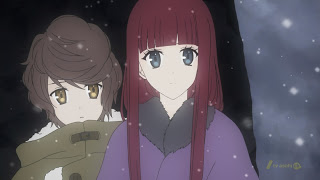 The other thing that really jumped out at me this week was that for a fantasy story of this nature, SSY is incredibly believable. As always that starts with the characters, and this show follows the too-rarely used but almost foolproof method of introducing and developing the characters as people before landing them in the middle of the plot. But there’s more to it, and I think it relates to the careful construction of the mythology. The series is seemingly being told as a remembrance by Saki, and the feeling is that we’re watching a historical fiction. There’s no sense than SSY is winging it, tweaking the mythology as needed to kick-start the plot – rather, the sense is that we’re watching the characters live out a story in a world that already existed. That’s a remarkable achievement for a premise like this, where every episode brings us new kernels of information that are, by the standards of “realism”, very far-fetched. Let’s leave aside the symbolic side of the story for the moment – we’ll get to that – though there’s no doubt that helps to ground things in reality too.
The other thing that really jumped out at me this week was that for a fantasy story of this nature, SSY is incredibly believable. As always that starts with the characters, and this show follows the too-rarely used but almost foolproof method of introducing and developing the characters as people before landing them in the middle of the plot. But there’s more to it, and I think it relates to the careful construction of the mythology. The series is seemingly being told as a remembrance by Saki, and the feeling is that we’re watching a historical fiction. There’s no sense than SSY is winging it, tweaking the mythology as needed to kick-start the plot – rather, the sense is that we’re watching the characters live out a story in a world that already existed. That’s a remarkable achievement for a premise like this, where every episode brings us new kernels of information that are, by the standards of “realism”, very far-fetched. Let’s leave aside the symbolic side of the story for the moment – we’ll get to that – though there’s no doubt that helps to ground things in reality too.
As is so often the case with this series, we’re told things that are obviously critical revelations, but there are pieces missing that prevent us from putting everything in context before we’re intended to. As we pick things up Satoru has headed back to the village to try and talk the group’s way out of trouble, and unbeknownst to him Saki follows close behind, leaving Mamoru and Maria behind. The power struggle between the Ethics Committee and the Board of Education has never been more obvious, as the latter takes the lead in questioning Saki, using a standard good cop, bad cop method (as is usually the case it’s the “good cop” – the Chairwoman – who’s the real threat). It’s clear immediately that Saki is in deep trouble, and the B of E has a usual method for dealing with troublesome children.
It’s hardly surprising that Tomiko-san would intervene here, and as usual she brings with her a wealth of new information. But there’s one piece of information we aren’t told – why was Mamoru targeted for disposal in the first place? The Vice-Chairwoman makes mention of Mamoru’s village being on alert, and ordered to stay indoors – the implication being that Mamoru was about to become a threat – but Tomiko takes them to task for the decision to eliminate him. She calls is unwise and unnecessary and scolds them for failing to complete the job, which is her nominal reason for absolving Saki of enough blame to spare her life. But it’s obvious that if push came to shove Tomiko would simply have refused to let the Board dispose of Saki, and there’s no question she’s the one who holds the real power. But absent the hard truth about why Mamoru was targeted in the first place we can’t make all the pieces fit yet.
No question, Tomiko gives us quite a few more pieces to work with. Not least among these is that she’s 267 years old, and has lived so long because she’s mastered the ability to use her cantus to repair her telomeres, the little tasseled ends of our chromosomes that are damaged every time a cell replicates, which eventually results in death (there’s some good science behind this plot thread). Just why she and apparently only she has developed this ability we don’t know, nor do we know whether she’s unable to teach others or simply chooses not to – and if the latter, why (she strongly implies she’ll teach Saki, so draw your own conclusions as to which is true). Tomiko credits her power to simple longevity, but there’s clearly more to her that’s formidable than simply her age. She also tells us that there are “50-60,000 people in the Japanese archipelago”, and says that each of them is potentially far more fearsome than a nuclear weapon. Again, there’s an implication here that Mamoru is a threat to become a fiend – but at the same time, Tomiko says she’ll guarantee Mamoru and Maria’s safety if Saki can bring them home. Someone is either lying or operating under a false assumption.
In purely practical terms, the situation is quite clear. Tomiko says that Mamoru and Maria will surely die if they don’t return and lays out a pretty unassailable case as to why (given that she’s casually petting three tainted cats as she does so lends her words a certain authority). Saki goes off to try and persuade her friends to return, and Tomiko sends Satoru after her for unknown reasons. It’s pretty obvious that everyone is this group is special – they’re the only children who haven’t been regularly hypnotized to leech the free will out of them (wolves are needed to defend the village too, not just lambs) – but also that even Tomiko’s powers and knowledge are limited, as she refers to Shun as “the one she had highest hopes for”. There’s undeniably as ominous note in Maria’s statement that “There’s no one as kind” as Mamoru, but given Saki’s earlier narration I suspect it’s Maria who’s the dangerous one here – which again loops us back to the question of why Mamoru was targeted in the first place. It’s a fascinating mystery, and it gets deeper as each revelation exposes more questions that demand answers. With its elegant plot construction, fascinating setting and identifiable characters whose interactions are fascinating to watch, Shin Sekai Yori continues to carve a place for itself as one of the most complete – and entertaining – series of the past year.
![[UTW]_Shinsekai_Yori_-_14_[h264-720p][C090297E].mkv_snapshot_04.04_[2013.01.05_21.53.57] [UTW]_Shinsekai_Yori_-_14_[h264-720p][C090297E].mkv_snapshot_04.04_[2013.01.05_21.53.57]](https://lh3.ggpht.com/-PzfBLe8PUOQ/UOg40X45XFI/AAAAAAACYh4/AxdG1Bbs5PM/%25255BUTW%25255D_Shinsekai_Yori_-_14_%25255Bh264-720p%25255D%25255BC090297E%25255D.mkv_snapshot_04.04_%25255B2013.01.05_21.53.57%25255D_thumb.jpg?imgmax=800) |
![[UTW]_Shinsekai_Yori_-_14_[h264-720p][C090297E].mkv_snapshot_05.04_[2013.01.05_21.54.57] [UTW]_Shinsekai_Yori_-_14_[h264-720p][C090297E].mkv_snapshot_05.04_[2013.01.05_21.54.57]](https://lh5.ggpht.com/-KMe3H8QuPX8/UOg45EFYGlI/AAAAAAACYiI/-tirJJ5ggsA/%25255BUTW%25255D_Shinsekai_Yori_-_14_%25255Bh264-720p%25255D%25255BC090297E%25255D.mkv_snapshot_05.04_%25255B2013.01.05_21.54.57%25255D_thumb.jpg?imgmax=800) |
![[UTW]_Shinsekai_Yori_-_14_[h264-720p][C090297E].mkv_snapshot_05.23_[2013.01.05_21.55.16] [UTW]_Shinsekai_Yori_-_14_[h264-720p][C090297E].mkv_snapshot_05.23_[2013.01.05_21.55.16]](https://lh3.ggpht.com/-JkeI_6a_-zs/UOg49bH9mpI/AAAAAAACYiY/llm9bvQWjt0/%25255BUTW%25255D_Shinsekai_Yori_-_14_%25255Bh264-720p%25255D%25255BC090297E%25255D.mkv_snapshot_05.23_%25255B2013.01.05_21.55.16%25255D_thumb.jpg?imgmax=800) |
![[UTW]_Shinsekai_Yori_-_14_[h264-720p][C090297E].mkv_snapshot_06.00_[2013.01.05_21.55.53] [UTW]_Shinsekai_Yori_-_14_[h264-720p][C090297E].mkv_snapshot_06.00_[2013.01.05_21.55.53]](https://lh3.ggpht.com/-MQie2kwGoCw/UOg5AkS0H2I/AAAAAAACYio/DqFzWlW1hoE/%25255BUTW%25255D_Shinsekai_Yori_-_14_%25255Bh264-720p%25255D%25255BC090297E%25255D.mkv_snapshot_06.00_%25255B2013.01.05_21.55.53%25255D_thumb.jpg?imgmax=800) |
![[UTW]_Shinsekai_Yori_-_14_[h264-720p][C090297E].mkv_snapshot_07.24_[2013.01.05_21.57.28] [UTW]_Shinsekai_Yori_-_14_[h264-720p][C090297E].mkv_snapshot_07.24_[2013.01.05_21.57.28]](https://lh5.ggpht.com/-esLzkqG3pFs/UOg5DrFG2QI/AAAAAAACYi4/704eOH0Ga94/%25255BUTW%25255D_Shinsekai_Yori_-_14_%25255Bh264-720p%25255D%25255BC090297E%25255D.mkv_snapshot_07.24_%25255B2013.01.05_21.57.28%25255D_thumb.jpg?imgmax=800) |
![[UTW]_Shinsekai_Yori_-_14_[h264-720p][C090297E].mkv_snapshot_08.20_[2013.01.05_21.58.24] [UTW]_Shinsekai_Yori_-_14_[h264-720p][C090297E].mkv_snapshot_08.20_[2013.01.05_21.58.24]](https://lh3.ggpht.com/-PnzPCihrOV4/UOg5HhJ4OqI/AAAAAAACYjI/pdAXuTXrGIU/%25255BUTW%25255D_Shinsekai_Yori_-_14_%25255Bh264-720p%25255D%25255BC090297E%25255D.mkv_snapshot_08.20_%25255B2013.01.05_21.58.24%25255D_thumb.jpg?imgmax=800) |
![[UTW]_Shinsekai_Yori_-_14_[h264-720p][C090297E].mkv_snapshot_09.30_[2013.01.05_21.59.34] [UTW]_Shinsekai_Yori_-_14_[h264-720p][C090297E].mkv_snapshot_09.30_[2013.01.05_21.59.34]](https://lh5.ggpht.com/-DS2dgOAEsck/UOg5Krvu46I/AAAAAAACYjY/PwwNdJdqBk0/%25255BUTW%25255D_Shinsekai_Yori_-_14_%25255Bh264-720p%25255D%25255BC090297E%25255D.mkv_snapshot_09.30_%25255B2013.01.05_21.59.34%25255D_thumb.jpg?imgmax=800) |
![[UTW]_Shinsekai_Yori_-_14_[h264-720p][C090297E].mkv_snapshot_10.58_[2013.01.05_22.01.02] [UTW]_Shinsekai_Yori_-_14_[h264-720p][C090297E].mkv_snapshot_10.58_[2013.01.05_22.01.02]](https://lh6.ggpht.com/-JkqOToAWvy8/UOg5OnITAoI/AAAAAAACYjo/_VDeSkKlJN4/%25255BUTW%25255D_Shinsekai_Yori_-_14_%25255Bh264-720p%25255D%25255BC090297E%25255D.mkv_snapshot_10.58_%25255B2013.01.05_22.01.02%25255D_thumb.jpg?imgmax=800) |
![[UTW]_Shinsekai_Yori_-_14_[h264-720p][C090297E].mkv_snapshot_11.04_[2013.01.05_22.01.08] [UTW]_Shinsekai_Yori_-_14_[h264-720p][C090297E].mkv_snapshot_11.04_[2013.01.05_22.01.08]](https://lh6.ggpht.com/-2FeslZjWRSo/UOg5RWVQbSI/AAAAAAACYj4/5-qg4RnTLdI/%25255BUTW%25255D_Shinsekai_Yori_-_14_%25255Bh264-720p%25255D%25255BC090297E%25255D.mkv_snapshot_11.04_%25255B2013.01.05_22.01.08%25255D_thumb.jpg?imgmax=800) |
![[UTW]_Shinsekai_Yori_-_14_[h264-720p][C090297E].mkv_snapshot_12.36_[2013.01.05_22.02.40] [UTW]_Shinsekai_Yori_-_14_[h264-720p][C090297E].mkv_snapshot_12.36_[2013.01.05_22.02.40]](https://lh4.ggpht.com/-66r3zG1xmxI/UOg5VCFLveI/AAAAAAACYkI/GAnn_zoTUsk/%25255BUTW%25255D_Shinsekai_Yori_-_14_%25255Bh264-720p%25255D%25255BC090297E%25255D.mkv_snapshot_12.36_%25255B2013.01.05_22.02.40%25255D_thumb.jpg?imgmax=800) |
![[UTW]_Shinsekai_Yori_-_14_[h264-720p][C090297E].mkv_snapshot_12.54_[2013.01.05_22.02.57] [UTW]_Shinsekai_Yori_-_14_[h264-720p][C090297E].mkv_snapshot_12.54_[2013.01.05_22.02.57]](https://lh3.ggpht.com/-bE5S1p7pTbo/UOg5dio8niI/AAAAAAACYkY/2Vw4_5izigw/%25255BUTW%25255D_Shinsekai_Yori_-_14_%25255Bh264-720p%25255D%25255BC090297E%25255D.mkv_snapshot_12.54_%25255B2013.01.05_22.02.57%25255D_thumb.jpg?imgmax=800) |
![[UTW]_Shinsekai_Yori_-_14_[h264-720p][C090297E].mkv_snapshot_14.08_[2013.01.05_22.04.24] [UTW]_Shinsekai_Yori_-_14_[h264-720p][C090297E].mkv_snapshot_14.08_[2013.01.05_22.04.24]](https://lh6.ggpht.com/-Ci9egWyk98Y/UOg5f3rGsvI/AAAAAAACYko/lP8hA2FMM08/%25255BUTW%25255D_Shinsekai_Yori_-_14_%25255Bh264-720p%25255D%25255BC090297E%25255D.mkv_snapshot_14.08_%25255B2013.01.05_22.04.24%25255D_thumb.jpg?imgmax=800) |
![[UTW]_Shinsekai_Yori_-_14_[h264-720p][C090297E].mkv_snapshot_14.57_[2013.01.05_22.05.13] [UTW]_Shinsekai_Yori_-_14_[h264-720p][C090297E].mkv_snapshot_14.57_[2013.01.05_22.05.13]](https://lh6.ggpht.com/-aa5IRARzf2k/UOg5inmfwuI/AAAAAAACYk4/VUf70s_954k/%25255BUTW%25255D_Shinsekai_Yori_-_14_%25255Bh264-720p%25255D%25255BC090297E%25255D.mkv_snapshot_14.57_%25255B2013.01.05_22.05.13%25255D_thumb.jpg?imgmax=800) |
![[UTW]_Shinsekai_Yori_-_14_[h264-720p][C090297E].mkv_snapshot_15.20_[2013.01.05_22.05.36] [UTW]_Shinsekai_Yori_-_14_[h264-720p][C090297E].mkv_snapshot_15.20_[2013.01.05_22.05.36]](https://lh4.ggpht.com/-PkGz6pcmzko/UOg5k2bsy2I/AAAAAAACYlI/oeVqujQFleY/%25255BUTW%25255D_Shinsekai_Yori_-_14_%25255Bh264-720p%25255D%25255BC090297E%25255D.mkv_snapshot_15.20_%25255B2013.01.05_22.05.36%25255D_thumb.jpg?imgmax=800) |
![[UTW]_Shinsekai_Yori_-_14_[h264-720p][C090297E].mkv_snapshot_16.12_[2013.01.05_22.06.44] [UTW]_Shinsekai_Yori_-_14_[h264-720p][C090297E].mkv_snapshot_16.12_[2013.01.05_22.06.44]](https://lh6.ggpht.com/-K4OZuhgzMyQ/UOg5nR34_oI/AAAAAAACYlY/HLrMsJKiTCI/%25255BUTW%25255D_Shinsekai_Yori_-_14_%25255Bh264-720p%25255D%25255BC090297E%25255D.mkv_snapshot_16.12_%25255B2013.01.05_22.06.44%25255D_thumb.jpg?imgmax=800) |
![[UTW]_Shinsekai_Yori_-_14_[h264-720p][C090297E].mkv_snapshot_18.01_[2013.01.05_22.08.33] [UTW]_Shinsekai_Yori_-_14_[h264-720p][C090297E].mkv_snapshot_18.01_[2013.01.05_22.08.33]](https://lh5.ggpht.com/-mBwus-1h5eI/UOg5p_BFYPI/AAAAAAACYlo/DBAQpl6v2uM/%25255BUTW%25255D_Shinsekai_Yori_-_14_%25255Bh264-720p%25255D%25255BC090297E%25255D.mkv_snapshot_18.01_%25255B2013.01.05_22.08.33%25255D_thumb.jpg?imgmax=800) |
![[UTW]_Shinsekai_Yori_-_14_[h264-720p][C090297E].mkv_snapshot_19.01_[2013.01.05_22.09.33] [UTW]_Shinsekai_Yori_-_14_[h264-720p][C090297E].mkv_snapshot_19.01_[2013.01.05_22.09.33]](https://lh6.ggpht.com/-AWxcneeWiTQ/UOg5vjsbxtI/AAAAAAACYl4/GUaGixac8W8/%25255BUTW%25255D_Shinsekai_Yori_-_14_%25255Bh264-720p%25255D%25255BC090297E%25255D.mkv_snapshot_19.01_%25255B2013.01.05_22.09.33%25255D_thumb.jpg?imgmax=800) |
![[UTW]_Shinsekai_Yori_-_14_[h264-720p][C090297E].mkv_snapshot_19.43_[2013.01.05_22.10.15] [UTW]_Shinsekai_Yori_-_14_[h264-720p][C090297E].mkv_snapshot_19.43_[2013.01.05_22.10.15]](https://lh3.ggpht.com/-6LxdQutwbRQ/UOg5yMcyGPI/AAAAAAACYmI/LjWFAkOTjao/%25255BUTW%25255D_Shinsekai_Yori_-_14_%25255Bh264-720p%25255D%25255BC090297E%25255D.mkv_snapshot_19.43_%25255B2013.01.05_22.10.15%25255D_thumb.jpg?imgmax=800) |
![[UTW]_Shinsekai_Yori_-_14_[h264-720p][C090297E].mkv_snapshot_20.14_[2013.01.05_22.10.46] [UTW]_Shinsekai_Yori_-_14_[h264-720p][C090297E].mkv_snapshot_20.14_[2013.01.05_22.10.46]](https://lh6.ggpht.com/-rGwO3daNbdQ/UOg50qbj6gI/AAAAAAACYmY/EMgOEyB0xWM/%25255BUTW%25255D_Shinsekai_Yori_-_14_%25255Bh264-720p%25255D%25255BC090297E%25255D.mkv_snapshot_20.14_%25255B2013.01.05_22.10.46%25255D_thumb.jpg?imgmax=800) |
![[UTW]_Shinsekai_Yori_-_14_[h264-720p][C090297E].mkv_snapshot_20.50_[2013.01.05_22.11.35] [UTW]_Shinsekai_Yori_-_14_[h264-720p][C090297E].mkv_snapshot_20.50_[2013.01.05_22.11.35]](https://lh4.ggpht.com/-8Qk-JKcjV4s/UOg54NILNHI/AAAAAAACYmo/va_zRjpYl7Y/%25255BUTW%25255D_Shinsekai_Yori_-_14_%25255Bh264-720p%25255D%25255BC090297E%25255D.mkv_snapshot_20.50_%25255B2013.01.05_22.11.35%25255D_thumb.jpg?imgmax=800) |
![[UTW]_Shinsekai_Yori_-_14_[h264-720p][C090297E].mkv_snapshot_20.53_[2013.01.05_22.11.38] [UTW]_Shinsekai_Yori_-_14_[h264-720p][C090297E].mkv_snapshot_20.53_[2013.01.05_22.11.38]](https://lh3.ggpht.com/-Osh2Vs5p92c/UOg57eSRn-I/AAAAAAACYm4/4bBAhTyPVro/%25255BUTW%25255D_Shinsekai_Yori_-_14_%25255Bh264-720p%25255D%25255BC090297E%25255D.mkv_snapshot_20.53_%25255B2013.01.05_22.11.38%25255D_thumb.jpg?imgmax=800) |



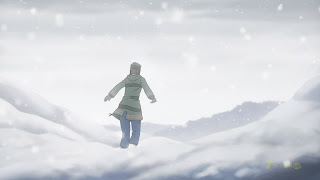
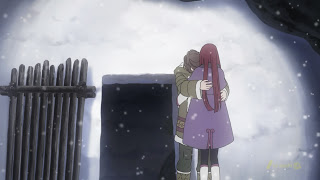

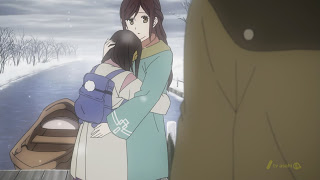
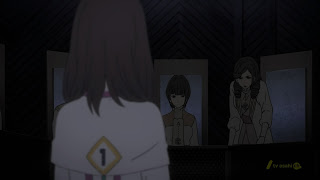
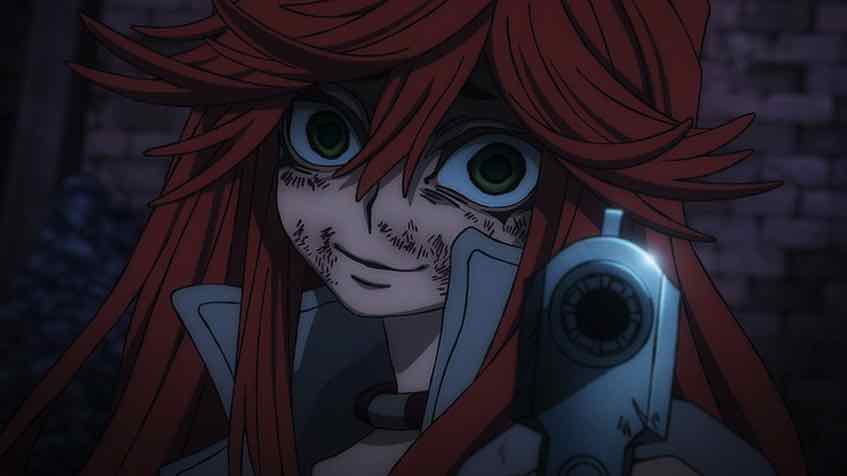

Kud
January 5, 2013 at 4:57 pmAs for why Tomiko says that Mamoru is dangerous (but she is willing to protect them should they return), I was thinking that every person with cantus is dangerous and they simply cannot allow anyone to be outside their control. I would think the real reason they could not allow Maria and Mamoru to live outside the village is that they could potentially have kids (the Board of Education seems to fixate on the face that it's both a boy and a girl missing).
Kud
January 5, 2013 at 4:59 pmfact* XD
Although there's still no solid answer of why they targeted Mamoru in the first place.
Anonymous
January 5, 2013 at 6:02 pmexactly….why is it that this village is so focused on same sex relationships until adulthood? does something bad come out of it? that part of the story has yet to be elaborated on. And about Maria…i dont think the death see is meant to cause in the future is completely intentional; i think something happens that was indirectly caused by her that sets off these unfortunate events that will happen in the future. I'm still not sensing any potential of malice from her although i could be wrong.
Stöt
January 5, 2013 at 5:55 pmThis is point of no return for Saki, though. Either she goes against the will of her friends or the will of the village.
How can she feel the need to protect the village that tries to kill her for every step she takes?
And another thing wrong with adopting the bonobo lifestyle: Horrible things have been done in the name of love. I felt uneasy about Maria last episode and that phrase from the narrator from episodes past kept ringing in my ear: "If Maria had never been born, so many lives would've been spared"
Litho
January 5, 2013 at 6:49 pmI had a kind of epiphany watching this ep. Well, I'm not sure epiphany is the right word, but whatever….
As a mobile developer, it struck me how similar this whole society is to the "walled gardens" that are the iOS (along with OSX Mountain Lion and Windows 8 on desktops) app store and operating system. No unsanctioned inter-app interaction allowed, little or no manual file-management, default lock-out of anything from non-sanctioned sources, reactive (rather than proactive) approach to ecosystem security.
Sorry for ranting. Good ep overall. Still not quite a fan of writers that enjoy killing children (I believe they were all unpopular in school), but I'll let it slide for this series, thanks to the quality.
SQA
January 5, 2013 at 8:32 pmI don't know if the writer likes killing children off, but he definitely has created the most vile and evil fictional society that I've ever come across. Don't forget that bit. 🙂
Anonymous
January 5, 2013 at 8:34 pmAm I the only one who thinks that the Board of Education order Mamoru elimination, so that Group One would get in trouble?
It really came across in this episode that the BoE is not to fond of Group One and the experiment of Tomiko.
r3dking
January 6, 2013 at 1:25 amI was struck by the strong implication that this was a long-term plan (but on whose part, exactly?) When Saki asks what was special about Team 1, Tomiko replies that normally children are indoctrinated in their sleep from a young age, but Saki & friends were left alone. That means the members of Team 1 were already picked long before any of them gained their power and graduated from lower school. How were they picked? Genetics? Family history? We know a little about Satoru's family background (he's related to Tomiko, although probably not as closely as described earlier given her age). We know a little about Saki's background (her mother is a "good leader" according to Tomiko). But so far there is no clue about what would have caused them to focus in advance on Mamoru or Maria or Shun.
Anonymous
January 6, 2013 at 3:30 amTomiko said she can guarantee Mamoru's and Maria's "inochi" if Saki was able to bring them back, which leads me to think she means just that – protecting their lives maybe by limiting their freedom and perhaps their free will as well (the daily hypnotization), placing them under constant surveillance and all. In any case if they were to come back, I think their lives would be changed forever, and I don't think it would be something we would call "life" by today's standard.
On a side note I like the scene where Tomiko and Saki on the boat enters a tunnel and the lighting darkens, giving a sense of secrecy to what Tomiko is about to reveal (and living for 267 years is not exactly something you get to hear in everyday news).
Highway
January 6, 2013 at 5:12 amI think the preview, combined with the information we've gotten before, raises an interesting possibility (although I'd put the chances at about 40% at best): Could the 'untold numbers' (from UTW, 'countless lives' elsewhere) be non-human? Given that the preview shows bakenezumi preparing for war, and we've seen bakenezumi war before (and comparing the Ground Spider soldiers to the Robber Fly members points out that the Ground Spiders had likely been breeding for war (and perhaps more human-shaped fighters in preparation for fighting PK humans with death feedback mechanisms?) for quite a while . We can't say for certain, since we don't know their life cycle, but it would likely have been years.
Given this, perhaps the 'untold numbers' aren't necessarily the humans, and Maria and / or Mamoru become fighters for a colony of bakenezumi, like Satoru and Saki did. I still think the biggest trigger for Crazy Maria is the death of Mamoru, but I'm now waffling on what causes his death, and who Maria will take it out on.
BTW, I love these episodes of SSY. This world is, as you say, fully realized in someone's head, and the possible contradictions, loose ends, and inconsistencies have been hammered out, welded shut, and ground smooth, giving us a seamless world that is being parceled out to us in interesting discussions between characters. And Tomiko-san has easily become my favorite character, possibly because she's the one who shows the closest ethics to what I consider ideal *for this world*. The BoE came off horribly in this episode, clearly rattled that Saki knows about the fujou neko, even though every child knows the rumors, and that Saki can contemplate her own demise as well as that of others.
r3dking
January 6, 2013 at 5:47 amIf you mean the voice-over at the end of Episode 2, Saki explicitly says "the lives of many people [大勢の人の命]". So I don't think it can refer to bakenezumi only, although the pictures of bakenezumi armies in the promos certainly suggests that they may be at the center of some large scale conflict.
Highway
January 7, 2013 at 4:37 amBut she doesn't say 'humans'. And I got the impression that Saki views the bakenezumi as 'people' from the previous arcs, even if they're not human. Perhaps this is a distinction that doesn't necessarily exist in Japanese, whether hito can *only* refer to humans, but I doubt it, since they have a separate name explicitly for 'human being'. I don't know enough Japanese yet to make the distinction.
But that's why I said it's only a 40% chance at best. However, it would be quite the change from what we've been thinking, that Maria somehow goes on a rampage and kills humans, as a fiend. I see this as a possible way out for the show.
Beckett
January 7, 2013 at 7:19 amThe thing that always strikes me about the posts on this show is how many of the commentators are immediately willing to peg this society as completely evil and beyond redemption. It's just as Tomiko says: they are dealing with people with enormous destructive potential. So my question to all of you finger pointers is this: How exactly would YOU handle this situation? If anyone has any better ideas I'd love to hear them. It seems to me that they are merely doing what they must in order to hold together the remnants of their society. Is the system perfect? No. The BoE are humans, they can make mistakes, as evidenced by Tomiko telling them that targeting Mamoru was a mistake. But if anyone has any better ideas of how they could manage people who can potentially wipe out entire towns effortlessly I'd seriously, no joking around, love to hear it.
Highway
January 7, 2013 at 3:45 pmI agree, Beckett. This society isn't 'evil' and 'vile'. I don't see what I would consider to be the necessary qualities of arbitrary and capricious cruelty, inherent disrespect for some or all people, or other things I'd consider 'evil' in this. Instead, it seems like you have a lot of humans that are trying to juggle, using Tomiko's metaphor, nuclear weapons with the knowledge that if even one is dropped, it will have a huge destructive impact.
It's almost certain that they are overly paranoid and cautious, and there are probably multitudes of children who have been disposed of that would have ultimately posed no threat. But how close to the line can they be? As a steward of a society, how much danger can you put your subjects in? The concept of granting human rights to children is a touchy one. Is 22 weeks after birth too early? Is 17 years too late? The answer to both is probably yes. I wonder how many children are disposed of after, say, age 15?
But the fact remains that these are people who are living in a time where they really don't have any better choices, given the circumstances that they're in.